Region II ranked 10th with the highest Basic Literacy Rate
89.5 or 9 out of 10 Filipinos in the region aged 5 years and over are basically literate or one who can read and write a simple message in any language or dialect with understanding, and to compute or perform basic mathematical operations.
Among all regions in the country, the basic literacy rate was highest in Region III (Central Luzon) at 92.8 percent, followed by CAR at 92.7 percent, and Region IV-A, 92.6 percent. The lowest basic literacy rate was observed in BARMM at 81.0 percent, followed by Region VIII at 85.1 percent and Region IX, 86.4 percent (see Figure 1).
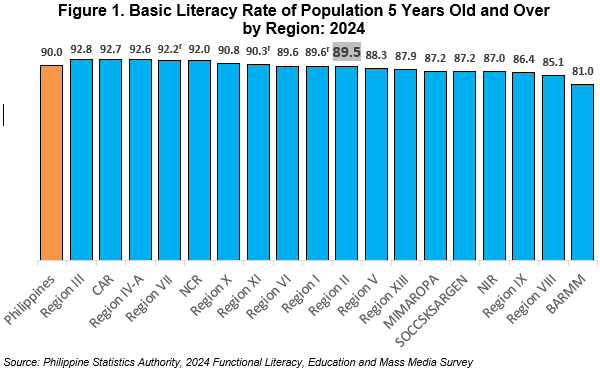
Nueva Vizcaya recorded the highest Basic Literacy Rate in Region II
Nueva Vizcaya recorded 91.0 percent basic literacy rate followed by Batanes at 90.8 percent, and Quirino at 90.7 percent (see Figure 2).
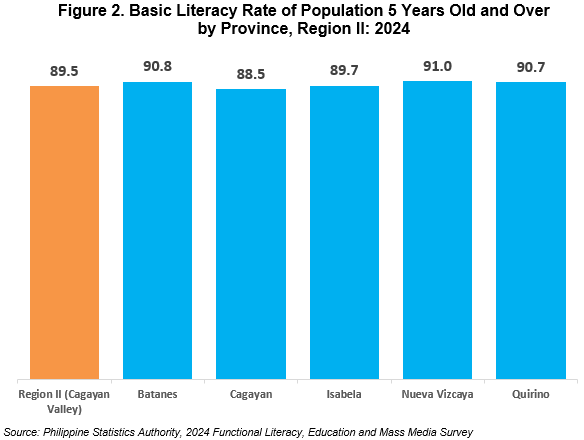
Basic literacy rate was higher for females than males
Females aged 5 years old and over showed a higher basic literacy rate at 90.5 percent compared to males on the same age range at 88.5 percent.
Age group 25 to 29 years old had the highest basic literacy rate at 96.9% while 60 years old and over reported the lowest basic literacy rate at 72.9% (see Figure 3).
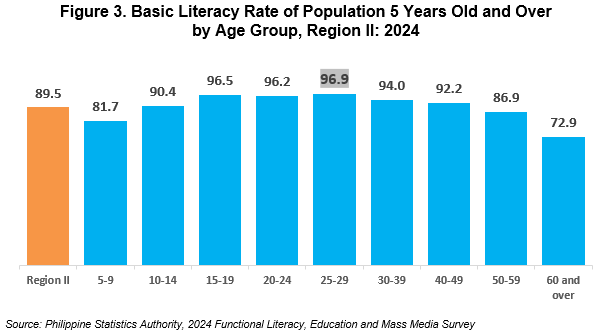
Based on highest grade completed, individuals in the region who reached or completed College recorded the highest basic literacy rate at 98.4 percent, while those who have No Grade Completed or with Early Childhood Education had the lowest rate at 51.4 percent (see Figure 4).
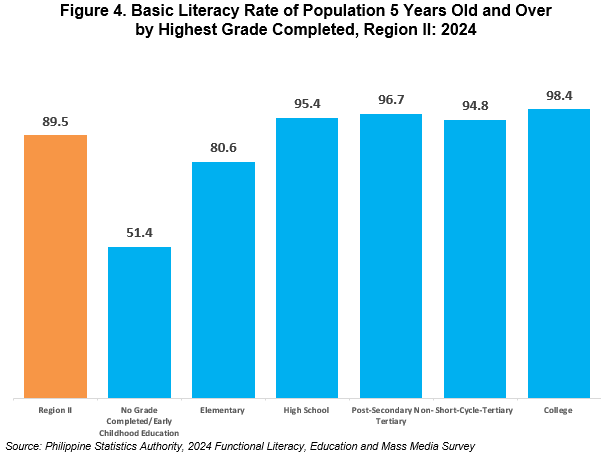
Region II ranked 8th with the highest Functional Literacy Rate at 69.4
7 out of 10 Filipinos in the region aged 10 to 64 years are functionally literate or one who can read, write, compute, and comprehend.
Functional literacy rate was highest in CAR at 81.2 percent, followed by NCR, Region IV-A, Central Luzon and MIMAROPA. Except for MIMAROPA, these regions also belong to the top 5 in terms of basic literacy rate. Functional literacy rate is lowest in Region IX at 59.3 percent, followed by Region VIII, Caraga, Ilocos Region and BARMM (see Figure 5).
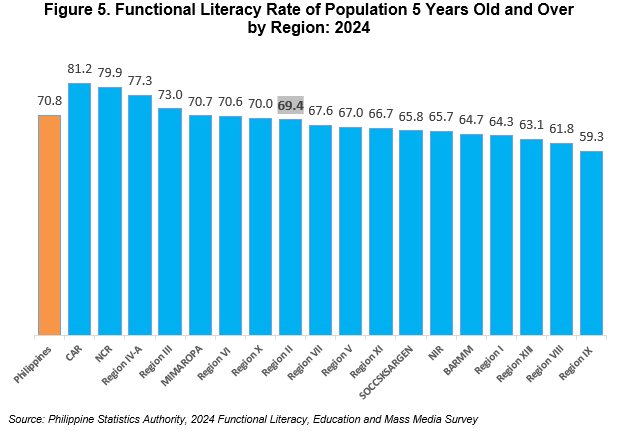
Across provinces in the region, functional literacy rate was highest in Batanes at 73.7 percent, followed by Quirino, and Isabela (see Figure 6).
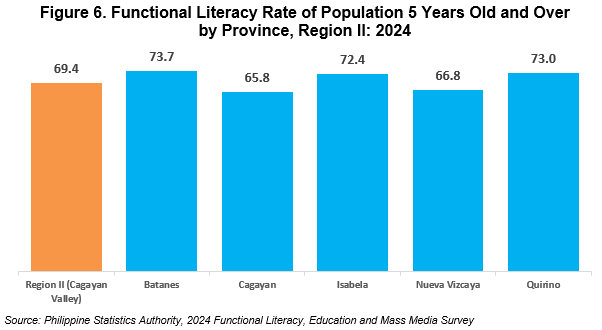
Functional literacy rate was also higher for females than males
Similar to the basic literacy rate, females showed a higher functional literacy rate at 73.7 percent compared to males at 65.2 percent.
Among age groups, individuals aged 20 to 24 years recorded the highest functional literacy rate at 78.9 percent, while those aged 60 and over had the lowest rate at 52.6 percent (see Figure 7).
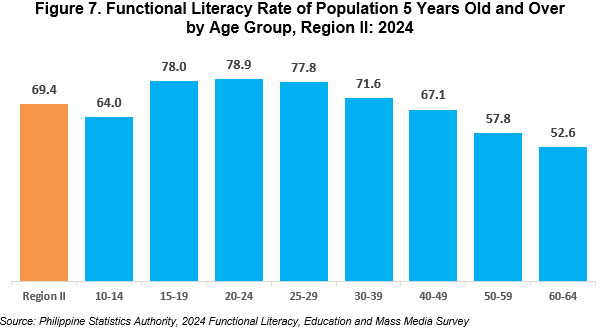
Individuals in the region who reached or completed College recorded the highest functional literacy rate at 84.0 percent, while Individuals who have No Grade Completed or formal education and those who only attained Early Childhood Education recorded the lowest rate, at 5.6 percent (see Figure 8).
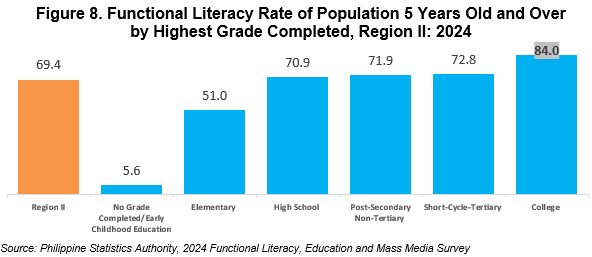
Internet use for Social Media increased
For mass media exposure to various internet platforms, internet use to access social media reported highest in 2024 at 78.0% among individuals 10 to 64 years old in the region. Internet use for Work/Research declined in 2024 by 11.9 percentage points, while internet use for Social Media increased by 12.1 percentage points.
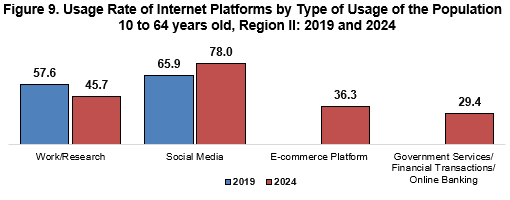
Engr. GIRME M. BAYUCAN
(Chief Statistical Specialist)
Officer-in-Charge, PSA-RSSO II
EMDP/MJCC/MJDSA/RMS
Technical Notes
The Functional Literacy, Education and Mass Media Survey (FLEMMS) is a household-based nationwide survey conducted every five (5) years in accordance with the Designation of Statistical Activities that will Generate Critical Data for Decision-making of the Government and the Private Sector (Executive Order No. 352 of 1996). The 2024 FLEMMS is the seventh in the series of literacy surveys in the country starting in 1989. Prior to this survey round, FLEMMS was conducted in 2019.
The survey operations for 2024 FLEMMS ran from September to October 2024.
The 2024 FLEMMS adopted the revised operational definition and methodology in estimating basic and functional literacy in the Philippines as approved by the Philippine Statistics Authority (PSA) Board through Resolution No. 13, Series of 2024.
Basic literacy is defined as the ability of a person to read and write a simple message in any language or dialect with understanding, and to compute or perform basic mathematical operations.
Functional literacy is the ability of a person to read, write, compute, and comprehend. In addition to the basic literacy skills, functional literacy includes higher level of comprehension skills, such as integrating two or more pieces of information and making inferences based on the given information.
Basic literacy rate is computed for individuals five (5) years old and over, while functional literacy rate is computed for individuals 10 to 64 years old.
Mass Media refers to technology that is intended to reach a mass audience. It is the primary means of communication used to reach the vast majority of the general public. Most common platforms for mass media are newspapers, magazines, radio, television, and the Internet.
